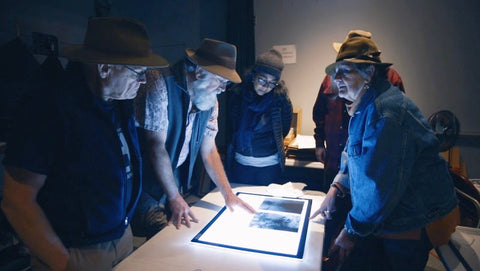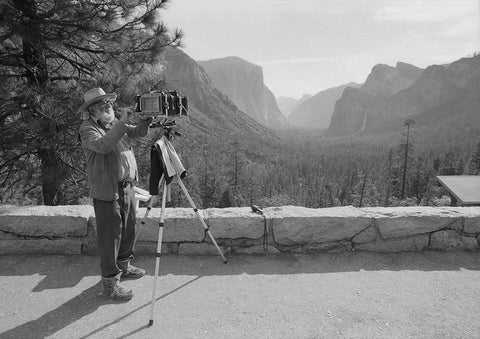
Palladium Printing, Gum Bichromate and Cyanotype over Palladium
Instructor: Kerik Kouklis
2025 Dates: May 14-17, November 5-8
Focus: Darkroom
Medium: Platinum/Palladium and Gum Bichromate
This fun and information-packed workshop will quickly bring you up to speed on making top-quality palladium prints from digital negatives. You will also learn the fundamentals of the gum bichromate and cyanotype processes and how to combine them with palladium to take your work in new directions.
Overview
Bridge the creation of digital negatives to classic palladium printing techniques in this four-day intensive, hands-on workshop with master printer Kerik Kouklis who is in his 25th year teaching for the Ansel Adams Gallery. Designed for beginning and intermediate students, this workshop begins with the techniques and subtleties involved in making top-quality palladium prints, including paper choices, contrast controls, archival processing techniques, environmental controls and the best workflow for consistent results.
Day 2 is dedicated to learning how to make high quality digital negatives using the QuickCurveDN system by Richard Boutwell and Epson printers. According to Kerik, “This newest entry into the digital negative software field is by far the best and easiest to use and teach. It has made my life and my students’ lives much easier.”
Day 3 is dedicated to learning the fundamentals of the gum bichromate process and how to combine it with palladium to provide additional tones and depth to your prints. This technique was popular in with the Picorialists including Steichen, Stieglitz, Coburn, etc.
On Day 4 you will learn the fundamentals of the New Cyanotype process and how to combine it with palladium to move your work in beautiful blue direction. We will also cover print retouching, sources for supplies and any final questions. You will leave the workshop with a pile of prints and the skills to take your work to the next level.
This workshop is limited to 6 persons.
This workshop is offered twice per year, in early spring and late fall.
SPRING 2025 - May 14-17
May is a time of changeable weather, and with it often dramatic lighting and atmospherics. One thing that can be stated with certainty, the waterfalls in the valley will be booming (you can hear Yosemite Falls from the gallery classroom). It is a great time for a primarily indoor program with short opportunities to photograph the spectacular vistas in Yosemite Valley.
FALL 2025 - November 5-8
Mid November typically has long bid adieu to the summer crowds. The weather is unpredictable and often unstable, leading to a high chance for dramatic clouds, mist, and rain or snow. By this time the cottonwoods and maples are typically bare, and the oaks have not yet shed their seasonal foliage. The contrast between pale granite and dark trees creates wonderful visual forms, perfect for exploring the rich tonalities inherent in platinum/palladium printing.
Currently the QCDN software by Richard Boutwell and Epson printers is only available for the MAC Operating System.
Workshop Details
| Platinum/Palladium Printing, Gum over Platinum |
|
|---|---|
| INSTRUCTOR | Kerik Kouklis |
| FOCUS | Darkroom |
| MEDIUM | Platinum/Palladium & Gum Bichromate |
| LEVEL | Beginner to Advanced |
| ATTENDEES | 6 |
| TUITION | $1225 |
| MATERIAL FEE | $250 |
Currently the QCDN software by Richard Boutwell and Epson printers is only available for the MAC Operating System.
In this intensive 4-day workshop offered twice a year, you will start by learning to make high quality digital negatives using the QCDN software by Richard Boutwell and Epson printers. This software has greatly simplified the process of making digital negatives and includes creative controls to enhance your work.Using your new digital negatives you will learn the techniques and subtleties involved in making top-quality platinum/palladium prints including paper choices, contrast controls, environmental controls and the best procedures for consistent results. Kerik's approach to platinum printing is simple and straightforward and does not involve complex sensitometry or math that can make the process appear much more difficult that it is. And Kerik's casual and friendly teaching style will have you making excellent prints almost from the start.
There will also be time to make new photographs in the incomparable Yosemite Valley. Each student will be asked to provide digital images before the workshop so printing can begin right away. You will also be making new negatives during the workshop. This workshop will allow you to make beautiful platinum/palladium and gum over platinum prints and have a great time doing it.
About the Instructor

KERIK KOUKLIS
Kerik Kouklis is a fine art and documentary photographer who has been involved in creating hand-made photographs since age twelve when his father set up a darkroom in the family’s basement. Born and reared in California with a background in music and geology, Kerik combines a contemporary eye when utilizing 19th, 20th and 21st Century processes to produce work that is uniquely his own. He has used these processes to create his work since 1990 and has been teaching workshops since 1997, both in his home studio and at various locations around the US, Canada and the UK.
Kerik was the recipient of the 2016 Yosemite Renaissance Artist in Residency. And in 2017 Kerik began working with color by combining inkjet pigments in his palladium printing. These prints are reminiscent of hand-colored photographs from the late 1800’s. Then in 2019 Kerik began to learned the very first photographic process called the daguerreotype. He is still honing his skills in this difficult but uniquely beautiful process. Also in 2019, Kerik became the President of the Board of Directors for the Viewpoint Photographic Art Center in Sacramento, California.
In recent years Kerik’s photographic travels have taken him to Iceland, Scotland, Norway, the Galapagos, Mongolia and Japan. He has adopted the use of a drone, where permitted, to make aerial photographs during these travels. Kerik has completed his first documentary short film “Mongolia in Winter'' and is now working on a documentary film about an Antarctic expedition that occurred in 1958.
Kerik’s work is currently represented in California by Oficino Uno in Carmel and the Ansel Adams Gallery in Yosemite where he has been teaching hand-made photographic techniques since 2000. His prints are held in private and corporate collections in North America and Europe as well as the Museum of Fine Art, Houston and the Hoyt Institute of Fine Arts, Newcastle, Pennsylvania. In 2019 Kerik became the President of the Board of Directors for the Viewpoint Photographic Art Center in Sacramento, California.
Kerik’s website is www.Kerik.com
Workshop FAQ
Find answers to your questions about our Photography Workshops in our FAQ. Please do not hesitate to reach out if you need additional help. You can reach us by email at photoed@anseladams.com or by phone (650) 692-3495.
Clothing / Dressing for the Elements
Physical Limitations Statement
This workshop may involve some walking and hiking around uneven, hilly, and rocky locations that may present a challenge to some attendees. The gallery workshop team requests your individual judgment to abstain from workshop activities that may be beyond your capabilities.
Although the workshop instructors will try to accommodate all attendees, please be advised that the gallery relies on your abstinence should you feel that a site location may not be safe for you.
Cancellation Policy
The Ansel Adams Gallery Multiple Day Workshop Cancellation Policy: We rely on your confirmed attendance to make important arrangements for the workshop. If you need to cancel, please inform a gallery representative in writing no fewer than 60 days prior to the first day of your scheduled workshop for a partial refund of your tuition that reflects the 10% non-refundable administration charge. Refunds cannot be made for cancellations initiated within 60 days of the first day of the scheduled workshop, or for no-shows, for any reason.
If you are concerned with the possibility of cancellation, please consider purchasing travel insurance.
Workshop registration is NOT transferable.
In the extremely rare event that The Ansel Adams Gallery needs to cancel a workshop, the gallery will refund your full tuition. However, The Ansel Adams Gallery will not be responsible for non-refundable airline tickets, car rentals charges, lodging reservations, or any other expense outside of the workshop tuition.
Lodging reservations made through Yosemite Hospitality - Aramark are fully refundable 14 days in advance of the scheduled first day of check in.
It is recommended not to purchase airline tickets or make non-refundable deposits on lodging that cannot be canceled 14 days prior to the initiation of the workshop event.
The Ansel Adams Gallery highly recommends travel insurance to help with an unfortunate travel event.





